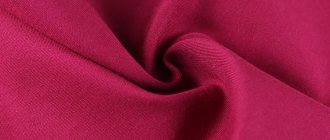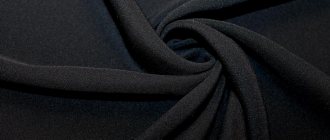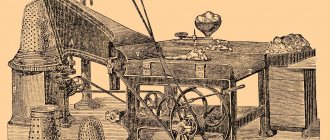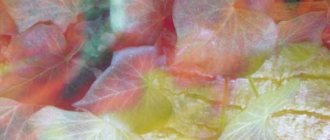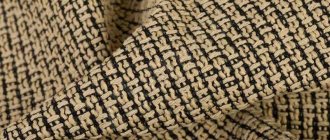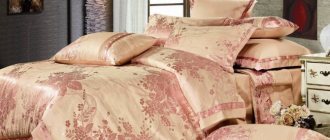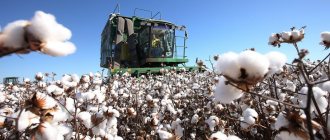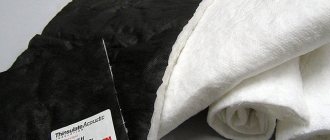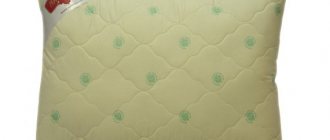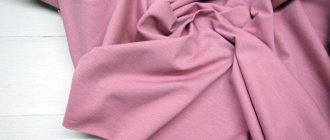Elastane ( elastane , EL, lycra, lycra , spandex , spandex ) - elastomeric polyurethane thread is a synthetic thread obtained on the basis of polyurethane rubber, similar in properties to rubber. The term " elastane " is more often used in Europe, while the concept " spandex » operate in USA and Canada. In its pure form, it is almost never used in production; it is added to other natural or synthetic fibers. Spandex is a component of many mixed fabrics: viscose , knitwear , cotton , silk Adding elastane to any fabric, cotton, viscose, silk, synthetics, makes them bielastic. That is, they easily stretch both lengthwise and crosswise. From what quantity elastane and is present in a particular material, the elasticity of the product depends.
The spandex and viscose ensemble has proven itself especially well in the sewing industry - this mixed fabric is elastic, soft and pleasant to the touch.
What is the difference between spandex?
Is there a difference between elastane and spandex? The answer can be given without even thinking. No, it's the same material. To explain this, you need to delve a little into history. In 1059, Joseph Shivers invented the presented type of fabric in the DuPont laboratory. It was this company that first patented the presented canvas. The most common place to find spandex is in a woman's wardrobe. The resulting products are tights and stockings. Thanks to the addition of spandex (elastane) to nylon, the fabric becomes much stronger and more elastic. In addition, it is possible to obtain a characteristic shine, which is the trump card of most hosiery manufacturers. Another name for spandex is lycra. This is also a very popular additive to various “elastic” materials, making the fabric much better. The term "lycra" is more often used in Europe, but the term " spandex " is most often used in the USA and Canada. That is, it is impossible to say which is better: lycra or elastane . Types of fabrics that contain spandex are available in a wide range. Their main advantage remains high elasticity and wrinkle resistance. The use of such characteristics is also very wide. Today, based on such material, underwear and even workwear are made.
Also popular are products in the area where the main requirement is the stretchability of the material.
What is made from elastane?
So, from elastane fabric, we can find:
- Casual clothes: turtlenecks, leggings, suits, jeans;
- Sports items: pants, jackets, T-shirts, T-shirts;
- Underwear, swimwear;
- Hosiery;
- Evening dresses;
- Stage, pop, carnival costumes.
Let me note once again that clothes made of elastane always look elegant, modern and festive.
Range
The range of polyurethane threads is determined by their purpose. They can serve as auxiliary when splicing (joining together) or are produced in the form of threads wrapped with other types.
Based on elastomeric threads in combination with conventional types of threads, various textile structures are produced - secondary non-uniform twisted and wrapped threads with unevenly loaded components. knitwear are made from them . Elastic threads and elastic fabrics are an indispensable material for a wide range of body-fitting textiles, including knitted sports, haberdashery and medical.
Synonyms
Polyurethane fibers are known by trade names: lycra, virin ( USA ), espa, neolan ( Japan ), spanzel ( Great Britain ), vorin ( Italy ), etc.
- "Spandex" is the general name for polyurethane elastic threads, which, unlike the names of most fibers, is not derived from their chemical composition. The word appeared as a result of rearranging the syllables in the word “expand” (stretch). In North America they prefer to say “spandex”, outside of it they prefer to call it “ elastane ” .
- Lycra is the most famous brand whose name is associated with elastane . Is a brand that was part of the DuPont company. “Lycra” gained particular popularity because almost all over the world this was the name given to any type of elastane. Invista does not condone such misconceptions and protects its brand in every possible way.
- Other brands of polyurethane fibers, among others, are Elaspan, also produced by Dorlastan and Linel.
Origin story
The material was first obtained in the 40s of the 20th century in the United States of America. It was developed and obtained by J. Shivers in one of the laboratories of the chemical company DuPont.
Initially, the resulting fiber was used in the manufacture of tightening belts and corsets.
Starting from the second half of the 20th century, elastane threads began to be used in the production of sportswear. Since the 70s, elastane has become widely used for the production of clothing of various types and applications.
Today, several brands of elastane are known:
- Lycra (DuPont de Nemours);
- Dorlastan (Bayer Corp);
- Linel (Fillatice, Italy);
- Spandex (Tong Hwa Synthetic Fiber, Taiwan).
Composition and properties
Elastane is a segmented polyurethane , it consists of flexible segments and rigid ligaments. The segments are connected to each other by ligaments (“bridges”), which protect the fibers from tearing during stretching.
Among the varieties of spandex, the two most popular types are two-dimensional and four-dimensional. Two-dimensional elastane stretches in one direction, either widthwise or lengthwise. Four-dimensional spandex, accordingly, stretches both in width and length.
Fabric containing lycra has a number of positive properties :
- Good elongation: the thread stretches 6-8 times.
- Elasticity: after stretching, the fabric returns to its original shape.
- Easy air permeability: the fabric, which includes lycra, is breathable, it “breathes”, the body feels comfortable under it.
- Wear resistance: spandex fibers present in the material make it strong and durable; the wear resistance of such fabric increases up to 2 times.
- Lightness and subtlety. The diameter of the lycra thread is small, the fabric from it is thin and almost weightless.
- Resistance to water and sun: does not fade, does not change color after washing and drying.
- Practicality: fabric with elastane does not wrinkle or deform after a long time of use.
- Density: the density of lycra is up to 1.3 g/cm3, which gives the material a stretch effect.
Fabric technology
Elastane fibers under a microscope
Elastane fibers are segments that are connected to each other by elastic “bridges” - this connection prevents the fabric from tearing during stretching.
Under a microscope, the structure of the material looks porous and airy.
Elastane polyurethane fibers can be obtained in several ways:
- the melt of raw materials is passed through extruders - molds;
- obtained by chemical formation;
- formed from dry or wet raw materials using appropriate production methods.
The result is a soft, smooth, silky and cool fabric that flows over the skin like water. Elastane can be dyed in absolutely any color, printed with a pattern or left plain.
Characteristics and production of matter
If we talk about the composition of the fabric, it refers to segmented polyurethane. The fibers of matter include flexible segments, which were connected using unique “bridges” - rigid connections. Thanks to this, the fiber is protected from ruptures of soft segments, and elastane also achieves the required level of elasticity.
The moment of manufacturing the material is a very responsible task; all activities must be carried out especially carefully and accurately. The fabric manufacturing process is carried out in a laboratory. For these purposes, wet, reaction and dry molding or extrusion from a polymer melt are used.
Polyurethane fibers are produced in four ways:
- chemical (reaction) formation;
- dry method of forming fibers from solution;
- wet method of forming fibers from solution;
- extrusion (extrusion) from a melt of polymer material.
All industrial methods for producing polyurethane fibers have a common stage - the synthesis of macrodiisocyanate (prepolymer) in a mass of polyetherdiol and diisocyanate (taken in molar excess) at 60 °C in a dry nitrogen environment. The subsequent stages - the production of polyurethane by the interaction of macrodiisocyanate with diamine (chain extender) and the formation of threads are carried out in various ways.
The reaction of macrodiisocyanate with diamine (chain extension reaction) is carried out in a solvent (mainly DMF). The resulting spinning solution is dosed through a spinneret into a heated (185-230 °C) spinning shaft with a height of up to 11 m, intensively blown with hot air (dry method) or into a precipitation water bath at room temperature (wet method).
In another method, diamine (up to 3%) is added to a precipitation bath with water or an organic solvent, into which macrodiisocyanate (or its solution) is squeezed out in thin jets through dies. The formation and precipitation of polyurethane urea occurs in a bath, so this method of producing polyurethane fibers is called reaction or chemical spinning.
With the dry spinning method, 1-16 complex threads come out of the spinning shaft, which, after applying a lubricant in an amount of 2-7%, are wound onto bobbins and subjected to heat treatment in a chamber at 80 ° C for 3 hours to reduce shrinkage of the thread in boiling water.
With the wet method, the formed threads are washed with water (90-95 °C) in machines where they are stretched approximately 1.5 times, wound onto bobbins and heat treated at 120 °C for 20-30 hours. With chemical spinning, the thread wound onto the spool, treated with water (40-80 °C, pressure 4 MPa) for 0.25-8 hours.
Advantages of the dry molding method over the wet one: higher concentration of the molding solution (32% versus 20%), higher molding speed (600 m/min versus 150 m/min), easier solvent regeneration.
A method for melt spinning polyurethane fibers is also being developed; the polyurethane must be thermoplastic, which is achieved by using diols—ethylene glycol or butylene glycol—as a chain extender.
The most widespread is the dry method of spinning polyurethane fibers (80% of their world production), 15% is produced using wet and chemical spinning methods, 5% of polyurethane fibers are melt-molded. In the dry method, polyether diol obtained by polymerization of THF is used for the synthesis of polyurethane; in other methods, predominantly polyether diols are used; in all methods, 4,4′-diphenylmethane diisocyanate is used, and sometimes a mixture of 2,4- and 2,6-toluene diisocyanates.
How it is produced
The material is synthesized in laboratory conditions under careful control.
Fiber forming methods:
- chemical;
- dry;
- wet;
- melting
Double-thread cotton fabric with elastane
The hardened fibers are washed, dried, wound onto spools and sent to weaving factories.
Advantages
For a more detailed description of the material, it is necessary to find out its advantages.
Wrinkle resistance, the ability to keep its shape, elasticity, does not restrict freedom of movement, does not wrinkle, very light, extends the life of the product, it is an incredibly thin and wear-resistant fiber. Its uniqueness lies in its strength and ability to stretch, exceeding its original length by 5-8 times, and also return to its original state when the load is removed. The latest modifications are resistant to sunlight, sea and chlorinated water, as well as all kinds of contaminants (oils, fats, cosmetics, sweat). Washable.
- Elastane is in such wide demand because of its most important advantage - excellent stretchability. Fibers can stretch 6-8 times. But do not forget about other, no less important characteristics that allow the use of elastane for the production of clothing:
- Elasticity. When the stretching is completed and there is no force applied, the material returns to its previous shape. Not subject to contamination. To remove the stain, you simply rinse the fabric in clean water.
- Thinness – elastane fibers have a very small diameter. Thanks to this quality, they can be very easily woven into other threads of both artificial and natural origin. This advantage of the material makes it universal in use.
- High level of breathability. In clothes containing elastane fibers, the skin will “breathe”, because the material does not interfere with air movement.
- Durability and wear resistance. Thanks to the weaving of elastane fibers into the main material, the finished product will serve you for a long time.
- Drapability.
- Lightweight, as the fabric weight is low.
- Density 1.1-1.3 g/cm³. Thanks to this, it is possible to obtain a stretch effect, which is in great demand among women.
- Resistance to environmental factors.
- Elastane is not affected by sunlight, is not destroyed by salts and does not allow color to fade.
- Ease of use.
- Products containing elastane threads do not wrinkle, are easy to wash and do not deform even after prolonged wear .
Kinds
Elastane is represented by such types as:
Lycra fiber . — Consider what lycra is. It is a highly elongable fiber that can withstand stretching up to 7 times its original length. Lycra threads can be transparent, translucent and white. Each of this species has its own density. Crepe elastane is a fabric with excellent drape and density. Its front side has a smooth and shiny surface, and its back side is matte, and the surface is coarse-grained.
Crepe elastane ,
Meryl polyamide 90 elastane 10 . Meryl polyamide 90 elastane 10 is a lightweight material with excellent breathability. In addition, the material boasts high strength indicators. This type of elastane does not wrinkle, drapes perfectly and provides air movement.
Combination with other materials
Material such as elastane is not used in its pure form. The thread of the material itself is very thin, but despite this, durable. Most often it is combined with other natural or synthetic materials. This combination and the amazing ability to stretch 6-8 times its own size make it possible to achieve an elastic and flexible product. The movement of clothing is determined by the percentage of fiber content. If they are present in large quantities, the mobility will be high. The combination of 95 viscose and 5 elastane . Elastane is a very popular type of polyurethane fiber. It is actively used for the manufacture of women's clothing, and it is also indispensable in the production of tights and stockings. Due to its unique ability to stretch, the demand for the product is increasing every day. When purchasing products made from elastane, every woman will look impressive, stylish, and, most importantly, comfortable and comfortable.
Elastane/cotton /viscose Fabric containing 88% cotton, 12% elastane does not allow the product to lose its shape, and also adds characteristics such as durability and wear resistance to the quality properties of cotton.
Cotton and viscose fabric with elastane provides excellent fit, lightness and comfort of wearing, without wrinkles. In addition, products containing elastane not only retain their shape for a long time, but also retain their original appearance even after numerous washes. Things with a small percentage of elastane fit better on the figure, they are tight, but after stretching they easily return to their original shape.
Where is it used?
Elastane is added to natural and synthetic fabrics. It is combined with the following:
- silk
- cotton
- viscose
- linen
- wool
- nylon
- polyamide
- polyester
Lycra is included in knitted and woven mixed fabrics. Fiber occupies a relatively small part, most often 3-5%. In some materials the content reaches 15-30% when it is necessary to increase density and extensibility. For example, for sportswear and swimwear.
Application and care
Elastane in mixed fabrics is used in the production of clothing for sports and dancing (leotards, shorts , leggings ). Suits are made from thick spandex for people involved in skiing and wrestling. Lycra is also used in the manufacture of swimsuits and swimming trunks. Fabric with elastane is smooth and glossy, it is ideal for sewing carnival and circus outfits; often this fabric also includes lurex shiny thread . The production of women's tights and leggings is another area where elastane . Spandex, a component of cotton, is used in the manufacture of tops, tanks and T-shirts. Stretch jeans, overalls and shorts are also made from cotton fabric with the addition of spandex.
Rules of care:
If you become the owner of clothing with a high polyurethane content, then you need to take into account specific care requirements. Spandex be washed at a temperature of 40 degrees and below in a delicate cycle or by hand. You cannot use bleaches in this case, but if you cannot do without them, then you should use the most gentle ones, in small quantities and only when the manufacturer has not directly prohibited their use. You should also not twist or squeeze it, as this may cause the fibers to burst and the product to lose its shape.
You can iron the material at a temperature no higher than 150 degrees, but it is often better to forget about the iron altogether . Thanks to the elasticity of the fabric, it will quickly take the shape of the body without ironing. You should also not dry clothes made from this fabric in various drying cabinets: elevated temperatures, especially prolonged exposure, render the fibers unusable. The process can be clearly seen if you heat a plastic bag - despite the difference in material, polyurethane will behave in much the same way, shrinking the fabric. If you take into account the rules of care, then there will be no problems with such clothes - the wear resistance and strength of fabrics of this type are quite high. It is best to dry spandex by laying it on a flat horizontal surface (for example, on a table), excluding direct sunlight, which will have the same effect as a drying cabinet.
For most varieties of spandex, dry cleaning is also contraindicated, as it can swell the fibers, turning the fabric from thin and smooth to waffle-like . In rare exceptions, the manufacturer indicates on the tag the possibility of dry cleaning, but often resorting to this method is not recommended in any case. In addition, the fiber perfectly absorbs odors from cleaning agents, which are then difficult to get rid of.
- hand wash in water at room temperature using mild washing powder for delicate fabrics, light spin without twisting;
- wash fabrics with elastane fibers with powders for fine fabrics.
- Do not dry in a dryer.
- Washing and ironing temperatures depend on the fibers in your blended fabric.
- machine wash in “hand wash” or “delicate” mode with water temperature up to 40 degrees, spin no more than 400 rpm;
- Colored elastane should be washed separately from white items;
- the use of conditioners, stain removers and bleaches is prohibited;
- drying - on a smooth surface, spread out, out of direct sunlight;
- ironing on “silk” or “delicate” mode;
- You cannot keep a lycra item stretched for a long time (on a hanger).
